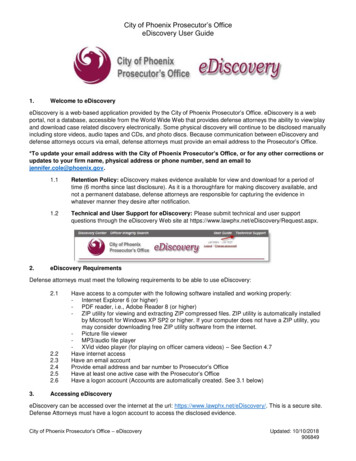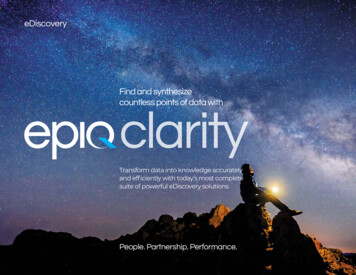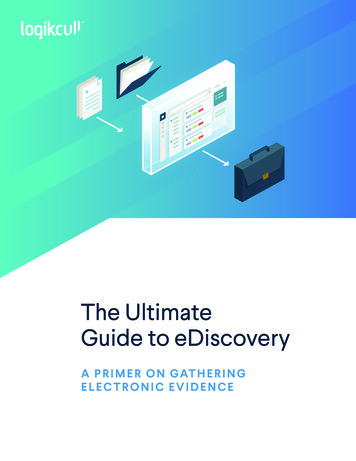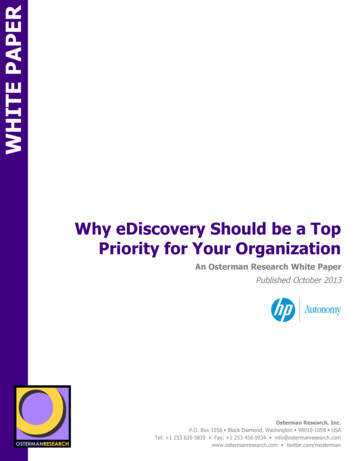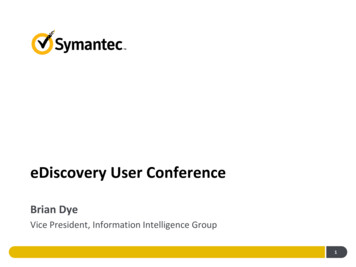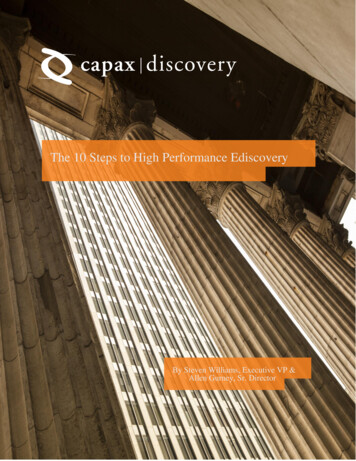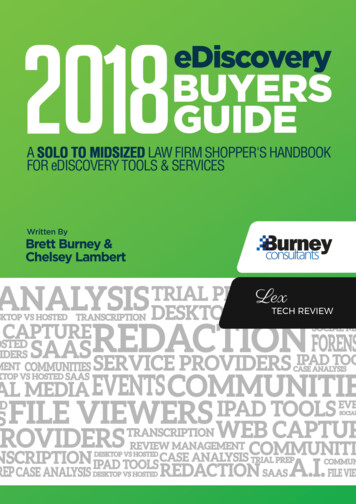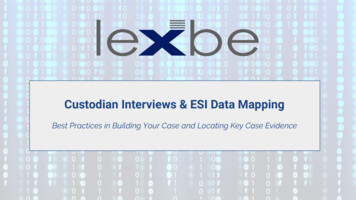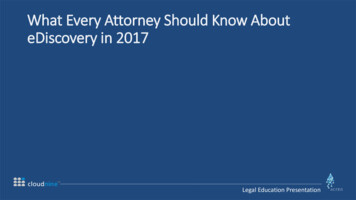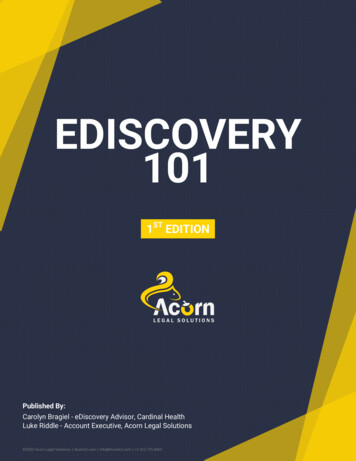
Transcription
EDISCOVERY1011ST EDITIONPublished By:Carolyn Bragiel - eDiscovery Advisor, Cardinal HealthLuke Riddle - Account Executive, Acorn Legal Solutions 2022 Acorn Legal Solutions AcornLS.com info@AcornLS.com 1 312.725.8455Page
ContentsThe eDiscovery Process .3Part 1Preservation .4Part 2Data Collection .6Part 3Processing & Early Case Assessment .8Part 4Review, Analysis and Production .10Key Terms to Know . 12Reference Materials . 14 2020 Acorn Legal Solutions AcornLS.com info@AcornLS.com 1 312.725.8455Page 2
Part 1: PreservationPreservation is the process of retaining physical and electronically storedinformation (ESI) in anticipation of litigation. A preservation policy shouldconsider defensibility in court, managing large data volumes, not disruptingother business practices , and keeping legal teams focused on the merits ofthe litigation.Defensible There are various ways to preserve ESI, and preservation is most commonly initiated through a legal hold. A legalhold is the process initiated by the legal team instructing relevant data owners, or custodians, to retain specified ESIin anticipation of litigation. Parties should take reasonable and proportionate steps to preserve “relevant and discoverable ESI within itspossession, custody or control. “1 When determining scope, consider the issues of the matter, accessibility of the ESI, proportional value of the ESI,and cost and burden associated with preserving the ESI.1 Consider all your client’s sources of data. Beyond just e-mail, there are data sources continuously emerging such ascollaborative communication software like Microsoft Teams. Creating a data map can assist with this process.Be Precise Counsel should apply a standard of reasonableness and proportionality to theirpreservation demands and efforts; weighing the costs and burdens with preservingthe ESI against the value of the dispute.2 Preserving each instance of ESI may not always be reasonable2 and can createcostly burdens. Vast volumes of data can disrupt case efforts, driving attentionaway from the merits of the litigation and consuming valuable resources. Courts have recognized preservation is not endless and does not require anorganization to “preserve every shred of paper, every e-mail or electronic document,and every backup tape.”3 Legal teams should avoid issuing a Litigation Hold Notice directing an organizationto simply preserve “relevant evidence” without providing guidance of what kind ofevidence is material to the potential litigation.4Terms to Know: Data Mapping: Theprocess of identifying andrecording the location andtypes of ESI within anorganization’s network andpolicies and proceduresrelated to that ESI. Spoliation: Thedestruction or alteration ofdata that might be relevantto a legal matter. Custodians: The person orentity that is responsiblefor, has administrativecontrol over, or has accessto electronically storedinformation (“ESI”). Meta Data: The data aboutthe data. Contextualinformation aboutcomputer files that helpsexplain how/when/where/why they were created.Can determine authenticityof data. Examples: sender,recipient, author, date,directory paths, lastmodified dates, andcreated dates.Issuing A good legal hold notice should clearly identify the reason for the hold, prohibit thedestruction of relevant documents, and should identify what sort of information isconsidered relevant. Put the Preservation Notice in writing, with clear instructions to suspend automaticdeletion and clear instructions on what should be preserved. Remind your client of the consequences of disregarding the legal hold, and advisethe client that if questions arise about whether something may be relevant, theyshould check with you before modifying. Open communication with the client will help ensure all relevant data sources arediscovered and relevant information is retained on a continuing basis. Include a process to track custodians’ receipt of the notice, responses toquestionnaires/surveys, any comments or notes regarding communication with thecustodians, etc. 2022 Acorn Legal Solutions AcornLS.com info@AcornLS.com 1 312.725.8455Page 4
Preservation Checklist(1) FOCUS ON THE KEY CUSTODIANS AND DATAMatters can involve an extensive list of custodians and large volumes of data from numerous sources. It’s helpful tostart small and scale up. There will be key custodians and highly relevant data that can be identified at the onset of thematter and this should work as a starting point to focus our initial efforts on. Starting overly broad can lead you to overpreserve, incur excessive costs, and distract from what actually matters.(2) ISSUING LEGAL HOLDSWith a narrow scope to start, legal holds should be issued swiftly. This ensures that custodians who may have relevantdata are accounted for and can be continuously added to the legal hold as our scope expands. This can beaccomplished easily, with a streamlined and standardized legal hold process. Include a process to receive and trackacknowledgment from the recipients.(3) DEVELOP AN INTERVIEW PROCESSCustodian interviews should have a routine process. Ideally, use a standardized interview template that includes thebasic questions that apply across matters. For example: Does custodian use cloud-based data sources? Does custodian have physical documents related to the matter? Does custodian have a personal email account related to the matter? Does custodian have a Thumb drives, external drives, shared drives/sites, cell phone/text messages, etc.?Custodian interview answers should then be centralized so they can be readily accessed and acted upon quickly.(4) ALL PRESERVATION STRATEGIES ARE NOT EQUALAs the importance of custodians and data will vary, our preservation strategy should align accordingly. Someapproaches, such as collecting the data as a means of preservation can create overwhelming volumes of data and costburdens. Typically, this approach should not be applied universally and be reserved for the most relevant data. Animmediate collection could be necessary if the custodian is leaving the company and to ensure they do not clean offcomputer or there is very high suspicion that it will go forward to litigation. Preserving in place is a viable option for oursecond-tier of custodians and data, that are likely to have relevant data in their custody or control. Preservation in placecan be very useful when the data is not stored locally, such as email accounts, sharedrives, or collaborative messagingapplications. Then for our broader scope, issuing a legal hold to the remaining custodians until we are able to determinetheir degree of relevancy to the matter. To support your preservation process, you should have the ability to put a holdon systems and individuals email, laptops, etc., so that normal retention policies no longer apply.(5) MAINTAIN A CENTRALIZED CUSTODIAN LISTA centralized list of custodians that notes their legal hold status and association in matters throughout yourorganization will allow you to monitor their preservation status and determine when we can release them from the legalhold. Organizations may have multiple matters simultaneously, with a custodian being involved in more than one at thesame time. With a centralized custodian list, we can ensure that we are not prematurely releasing a custodian from thelegal hold.(6) RELEASING LEGAL HOLDEqually as important as issuing legal holds, is ensuring we release them. With our centralized custodian list, we monitorcustodians’ involvement in various legal holds and determine when and who we can release as matters settle. Failing torelease legal holds can create undue burden on custodians and develop into over preserving. This will create excessivestorage, hosting, data management, and data security obligations and costs. A process should be developed todetermine when a custodian can be released from the legal hold. Additionally, outside or opposing counsel should bemanaging data that has been produced accordingly and providing certifications of deletion. 2022 Acorn Legal Solutions AcornLS.com info@AcornLS.com 1 312.725.8455Page 5
Reference Materials1. The Sedona Conference, Commentary on Legal Holds, Second Edition: The Trigger & TheProcess, 20 SEDONA CONF. J. 341 (2019).2. The Sedona Principles, Third Edition: Best Practices, Recommendations & Principles forAddressing Electronic Document Production, 19 Sedona Conf. J. 1 (2018).3. Zubulake v. UBS Warburg LLC, 220 F.R.D. 212., (S.D.N.Y. 2003).4. Samsung Electronics Co., Ltd. v. Rambus, Inc., 439 F. Supp. 2d 524 (E.D. Va. 2006).5. Equal Employment Opportunity Commission v. M1 5100 Corp., (S.D. Fla. 2020). 2022 Acorn Legal Solutions AcornLS.com info@AcornLS.com 1 312.725.8455Page 14
(3) DEVELOP AN INTERVIEW PROCESS Custodian interviews should have a routine process. Ideally, use a standardized interview template that includes the basic questions that apply across matters. For example: Does custodian use cloud-based data sources? Does custodian have physical documents related to the matter?
